WRC Braking technology
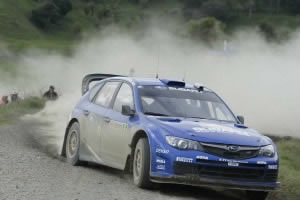
Brakes are one of the most critical components on WRC racing car, and same stand for a tarmac or gravel events, and in slowing the car down play just as important a role in boosting overall speed. Quite apart from simply slowing the car, rally drivers use the brakes to position and balance the car on its approach to corners and to slide through tight hairpins whilst maintaining engine speed.
Each car's brake setup is also different for gravel and asphalt rallies, owing to the different demands and usage in each condition.
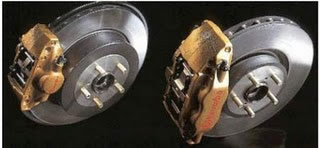
For an asphalt rally, the WRC car mostly use 366X24 mm 6 groove brake discs mounted to aerospace grade aluminium mounting bells at the front of the car and 305mm discs at the rear.
These are wrapped by eight-pot calipers with titanium pistons on fronts and four-pot variants at the rear. On asphalt there is generally more available grip than on gravel, so more force can be exerted through the brakes without the wheels locking, generating more friction. Speeds are also generally higher, leading to higher loads.
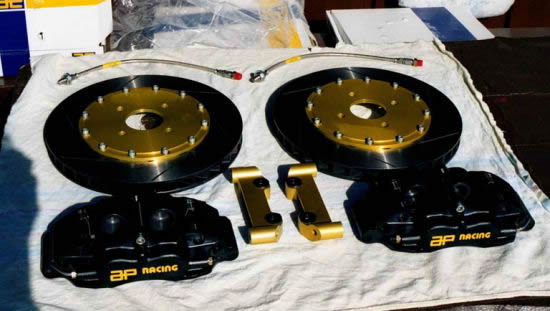
As there is a lot of grip, you push the brakes quite hard so there is a lot of energy to dissipate in the brakes. There is a lot of heat being generated and the stages can be long. It is important that the temperatures do not keep going up and down and that they stabilize quite quickly. If the temperature keeps increasing the brakes will end up fading and losing power and performance. Running on tarmac means energy levels absorbed by the WRC brakes are considerably greater than those experienced during rallies on other surfaces.
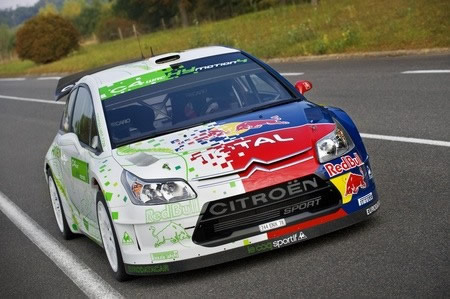
Often, disc temperatures will reach extreme levels of up to 900°C (road car discs would not survive much above 600°C, at which point cast iron is starting to glow red). Tarmac pads for high performance WRC use are specially manufactured to offer possibly the highest temperature capability. Their unique formulation gives phenomenal bite and braking power, even at temperatures at which gravel rally pads either fade or start to deposit heavily on the discs, which can give rise to a loss of performance and consistency. Discs are often water cooled to improve efficiency.
 |
| Collection of WRC braking disc pads used by all WRC teams and considered as best racing products: Alcon-Prodrive, Ferodo, Mintex, Carbon Metallic, Endless, Pagid, Carbonne Lorraine, Pro Friction, AP Racing |
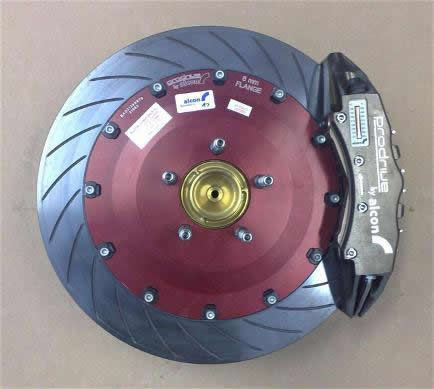 |
Alcon Prodrive 6 pot water cooled caliper with 366 x 32 disc used in WRC, on the picture outer side of the grooved disc |
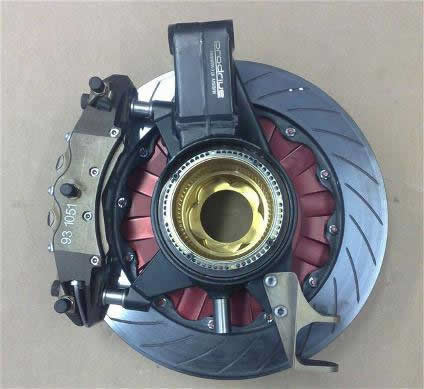 |
Same as up, Alcon Prodrive 6 pot water cooled caliper with 366 x 32 disc used in WRC, on the picture inner side of the grooved disc. You can see suspension attachment points |
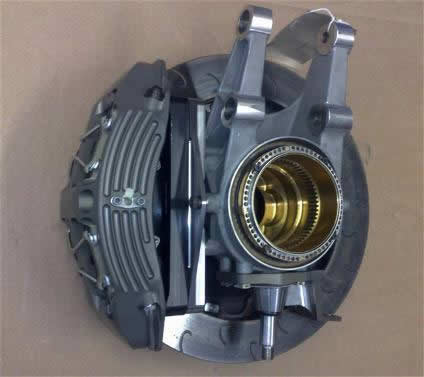 |
Alcon Prodrive 8 pot water cooled caliper with 366 x 40 disc used in WRC, on the picture inner side of the grooved disc. You can see suspension attachment points. |
The bigger discs and calipers enable more braking force to be exerted, slowing the car down more rapidly, and the increased surface area is more efficient as dissipating the resulting heat. Whilst the discs and brake pads are designed to work at a high temperature, there is an optimum level and overheating can lead to reduced performance. Never normally a consideration on the road, water jets can be used to cool the front brakes which can reach temperatures of 900°Celsius. The brake fluid temperature can also reach 120°Celsius.
There are two main reasons why bigger brakes are the key to getting more stopping power:
- Bigger brakes (discs) have more surface area and can therefore get rid of more heat than smaller brakes, and heat is a brakes worst enemy. The heat can do three things: Melt the surface of your brake pads (glazing) which makes them smooth and reduce the friction between pad and rotor. Heat can make your calipers so hot that the brake fluid boils; boiling creates air bubbles and bubbles are compressible, which in turn allows you to press your brake pedal to the floor without any significant effect on your car's speed. And last but not least high temperatures are not good for the brake discs: Discs will tolerate heat up to a certain temperature, but higher than that they will warp, or even crack if the temperature is high enough. That is unless you have carbon brake discs like the ones used on F1 cars.
- Bigger brakes have more leverage on the tire so less braking force from the brake makes for more stopping power at the tire.
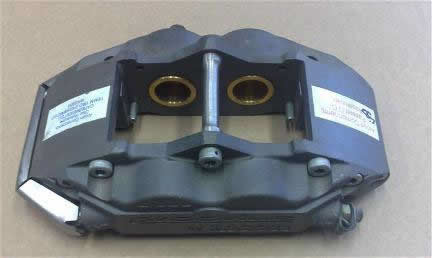 |
WRC Brake 4 pot calipers Prodrive Alcon S4 - S10 |
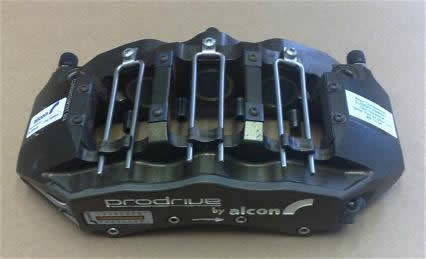 |
WRC Brake 6 pot calipers Prodrive Alcon S6 - S10 |
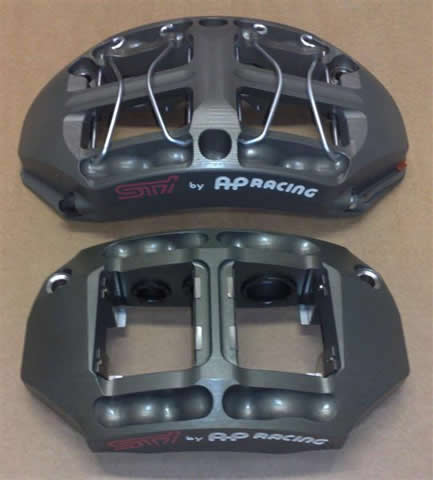 |
WRC Brake 6 pot calipers AP-Racing S11-on |
By contrast, the brake setup for a gravel car is typically smaller, owing to the facts that braking forces are reduced on the loose surface, and the smaller wheels used on gravel would not physically fit over asphalt brake discs. In these conditions, the front discs are 305mm racing items, coupled to four-pot calipers both front and rear. The rear brakes remain the same for both surfaces.
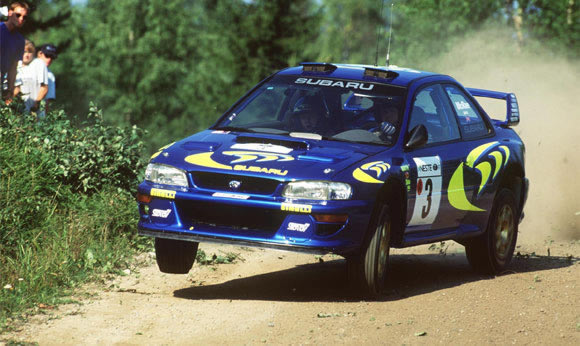
On asphalt, the front brakes do the vast majority of the work in slowing the car down, so brake bias will tend to be set towards the front. Brake bias is the split of the braking force between the front and rear brakes. On gravel, the bias will be more towards the rear to help slide the car into the corners.
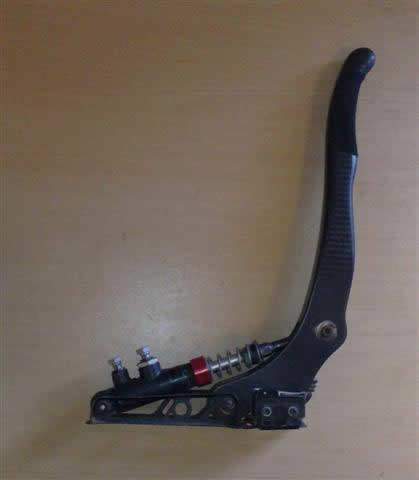 |
Hydraulic handbrake system in two flavors. on the picture above you can see handbrake version mostly used in WRC (Prodrive WRC GD Impreza carbon handbrake). Other version showed on the lover picture is handbrake stick and sequential shifter in Mini WRC car for 2013.. |
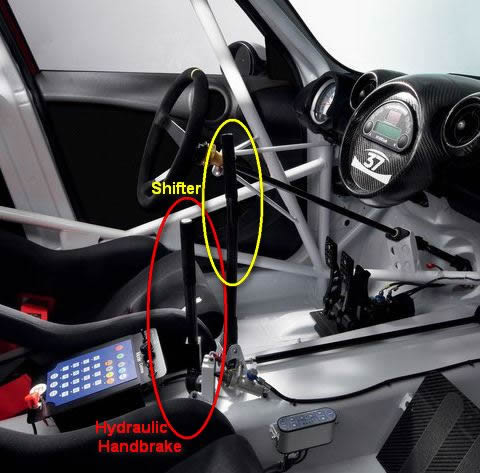 |
To help slide the rear on asphalt or gravel, the handbrake system is hydraulic and so very efficient. The lever is positioned where you'd expect a road car's gear stick to be, meaning that drivers can easily reach without moving their hand too far from the steering wheel. As with the rear brake setup, the handbrake is the same for both gravel and asphalt rallies.
To have a complete picture of performance driving, take a look at Corners, Setup, Traction circle, Using tires, Left foot braking, braking, advanced braking, Slipstreaming, drifting, cornering, shifting, Heel and toe driving technique and steering technique articles
Back to the top of the page






